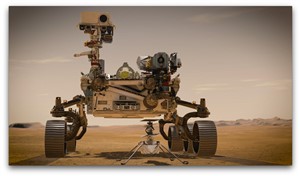Perseverance Celebrates 1st Birthday and Fires 1 Millionth Laser Shot on Mars
February 21, 2022
-One year ago almost to the day, on the evening of 18 February 2021, the Mars 2020 mission’s Perseverance rover landed in Jezero Crater, carrying with it the French-U.S. SuperCam, a greatly enhanced version of the ChemCam instrument already operating on the NASA MSL mission’s Curiosity rover on Mars since August 2012. The Los Alamos National Laboratory (LANL) and a consortium of French research laboratories with the IRAP – Astrophysics and Planetology Research Institute (CNRS/CNES/Paul Sabatier University Toulouse III) as science lead, developed both instruments jointly. SuperCam and ChemCam have now fired one million laser shots between them on Mars.
The one-millionth laser shot was commanded from the French Operations Centre for Science and Exploration (FOCSE) at CNES’s field centre in Toulouse, France. This symbolic milestone is the latest in a unique scientific and technological adventure that has already yielded a wealth of results. The Curiosity and Perseverance rovers are operated alternately for one week from the FOCSE and then from LANL in the United States.
Developed and built by Thales and overseen by CNES under R&D programmes first started 20 years ago, SuperCam’s and ChemCam’s lasers are the most powerful currently operating on the surface of another planet. Able to reach targets within a 10-metre radius of their rovers, these lasers expand the field of possibilities for scientific investigation while reducing driving distances.
ChemCam’s laser – the first power laser on the surface of another planet – delivered in 2008 and operational since August 2012, is still in service and has clocked up 887,000 firings, each yielding a measurement of chemical composition. Over the 25 kilometres they have covered on the surface of Mars, Curiosity and ChemCam have revealed the existence of ancient environments that could once have supported microscopic lifeforms.
Like ChemCam, SuperCam fires an infrared laser beam at target rocks, vaporizing them at the impact point into a plasma at a temperature of around 10,000°C. An optical spectrometer combined with a camera then analyses the flash from this plasma using a technique called Laser-Induced Breakdown Spectroscopy (LIBS) to determine a rock’s elemental chemical composition.
Unlike ChemCam, SuperCam can fire a second green laser beam to determine the molecular composition of rocks non-destructively. The energy exchanged between the green laser beam and its targets generates light of a different colour that is then analysed to identify molecules in rocks. This molecular analysis technique, called remote Raman spectroscopy, is being tested out with Perseverance for the first time on Mars.
SuperCam’s laser, delivered in 2019 and operational on Mars since February 2021, has clocked up 62,000 firings of its green mineralogy laser and as many with its infrared laser. It has already made a decisive contribution to the initial science results of the Mars 2020 mission, proving that there was once a lake in Jezero Crater.
Source : Thales


